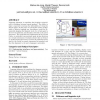Free Online Productivity Tools
i2Speak
i2Symbol
i2OCR
iTex2Img
iWeb2Print
iWeb2Shot
i2Type
iPdf2Split
iPdf2Merge
i2Bopomofo
i2Arabic
i2Style
i2Image
i2PDF
iLatex2Rtf
Sci2ools
ATAL
2008
Springer
2008
Springer
Politeness and alignment in dialogues with a virtual guide
Language alignment is something that happens automatically in dialogues between human speakers. The ability to align is expected to increase the believability of virtual dialogue agents. In this paper we extend the notion of alignment to affective language use, describing a model for dynamically adapting the linguistic style of a virtual agent to the level of politeness and formality detected in the user's utterances. The model has been implemented in the Virtual Guide, an embodied conversational agent giving directions in a virtual environment. Evaluation shows that our formality model needs improvement, but that the politeness tactics used by the Guide are mostly interpreted as intended, and that the alignment to the user's language is noticeable. Categories and Subject Descriptors H.5.2 [Information interfaces and presentation]: User interfaces--natural language General Terms Human Factors, Languages Keywords virtual agents, politeness, alignment
| Added | 12 Oct 2010 |
| Updated | 12 Oct 2010 |
| Type | Conference |
| Year | 2008 |
| Where | ATAL |
| Authors | Markus de Jong, Mariët Theune, Dennis Hofs |
Comments (0)

